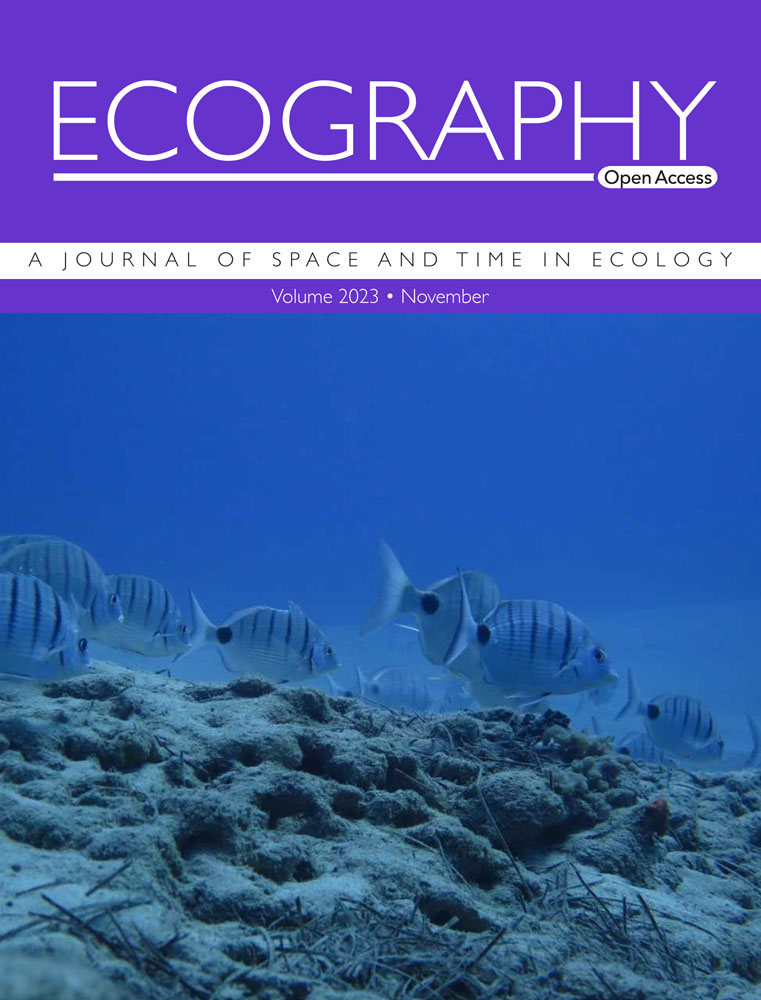环境和当地生境变量作为东南太平洋海岸潮下礁石营养相互作用的预测因子
IF 5.4
1区 环境科学与生态学
Q1 BIODIVERSITY CONSERVATION
引用次数: 0
摘要
温度通常驱动营养相互作用强度的纬度模式,包括消耗率。然而,当地社区和其他环境条件也可能影响消费,破坏纬度梯度,从而导致复杂的大尺度格局。本研究评估了智利沿海超过22度纬度(~ 2500公里)的环境变量和当地消费群体对捕食和草食的相对影响。在12个研究点采用动物食用量测定法(蟹类、鱿鱼类)和海带食用量测定法,对海带的食用量(2 h和24 h)和食用量(24 h)进行了评价,并测量了海水特征、生境特征和食用者群落特征等重要环境变量。对于每一种猎物类型,我们的目标是找出最能解释食用量变化的变量。捕食率与温度呈正相关,但也与溶解氧和较高的盐度呈正相关,所有这些变量都被认为有利于消费者的高代谢率。当地的栖息地特征(即较高的裸露岩石覆盖)对蟹类的捕食率产生了负面影响,这可能是因为在没有海藻的地区(海带或林下藻类),以蟹为食的大型掠食性鱼类(这也解释了更高的蟹类消费量)较少。有较高的下层藻类覆盖的草食减少,可能是由于存在替代,更美味的海藻。提供的海带叶片没有在绿单宁含量非常高的纬度上消费,这一事实表明消费与海藻适口性之间存在关系。由于许多解释变量没有表现出严格的纬度变化趋势,因此大规模消费模式可能会随着局部变异的来源而变化,从而影响消费者的新陈代谢、觅食效率和消费压力。本文章由计算机程序翻译,如有差异,请以英文原文为准。
Environmental and local habitat variables as predictors of trophic interactions in subtidal rocky reefs along the SE Pacific coast
Temperature generally drives latitudinal patterns in the strength of trophic interactions, including consumption rates. However, local community and other environmental conditions might also affect consumption, disrupting latitudinal gradients, which results in complex large-scale patterns. This study assessed the relative effect of environmental variables and local consumer communities on predation and herbivory along more than 22 degrees of latitude (∼2500 km) of the Chilean coast. Consumption assays with animal prey (porcellanid crabs and squidpops) and the kelp Lessonia spp. were used to assess predation (after 2 h and 24 h) and herbivory (after 24 h) at 12 study sites where important environmental variables (seawater characteristics, habitat features and consumer community characteristics) were measured. For each prey type, we aimed to identify the variables that best explained variation in consumption. Predation rates were positively related to temperature, but also with dissolved oxygen and higher salinities, all variables that are thought to favour higher metabolic rates in consumers. Local habitat characteristics (i.e. higher bare rock cover) negatively affected predation rates on porcellanid crabs, likely because large predatory fish feeding on crabs (which also explain higher crab consumption) are less abundant in seaweed-free areas (kelp or understory algae). There was a decrease in herbivory with higher understorey algae cover, possibly due to the presence of alternative, more palatable seaweeds. The fact that the offered kelp blades were not consumed at latitudes where phlorotannin contents were very high suggests a relationship between consumption and seaweed palatability. Since many of the explanatory variables did not show a strict latitudinal trend, large-scale consumption patterns can vary with sources of local variation that affect the consumer metabolism, foraging efficiency and consumption pressure.
求助全文
通过发布文献求助,成功后即可免费获取论文全文。
去求助
来源期刊

Ecography
环境科学-生态学
CiteScore
11.60
自引率
3.40%
发文量
122
审稿时长
8-16 weeks
期刊介绍:
ECOGRAPHY publishes exciting, novel, and important articles that significantly advance understanding of ecological or biodiversity patterns in space or time. Papers focusing on conservation or restoration are welcomed, provided they are anchored in ecological theory and convey a general message that goes beyond a single case study. We encourage papers that seek advancing the field through the development and testing of theory or methodology, or by proposing new tools for analysis or interpretation of ecological phenomena. Manuscripts are expected to address general principles in ecology, though they may do so using a specific model system if they adequately frame the problem relative to a generalized ecological question or problem.
Purely descriptive papers are considered only if breaking new ground and/or describing patterns seldom explored. Studies focused on a single species or single location are generally discouraged unless they make a significant contribution to advancing general theory or understanding of biodiversity patterns and processes. Manuscripts merely confirming or marginally extending results of previous work are unlikely to be considered in Ecography.
Papers are judged by virtue of their originality, appeal to general interest, and their contribution to new developments in studies of spatial and temporal ecological patterns. There are no biases with regard to taxon, biome, or biogeographical area.
 求助内容:
求助内容: 应助结果提醒方式:
应助结果提醒方式:


